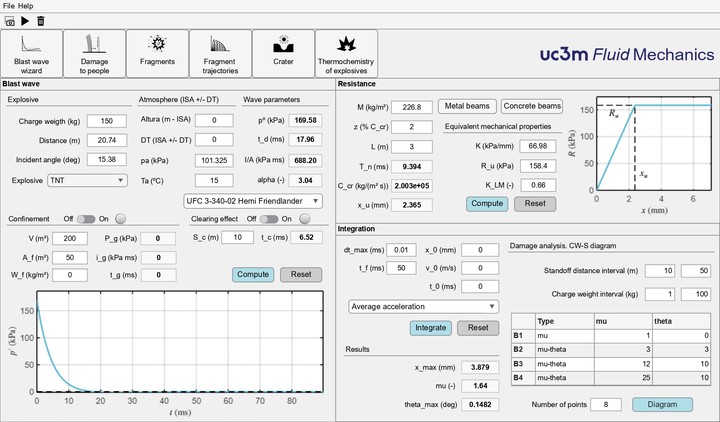Abstract
The dynamic response of structural elements subjected to blast loading is a problem of growing interest in the field of defense and security. In this work, a novel computational tool for the rapid evaluation of the effects of explosions, hereafter referred as SimEx, is presented and discussed. The classical correlations for the reference chemical (1 kg of TNT) and nuclear ( kg of TNT) explosions, both spherical and hemispherical, are used together with the blast wave scaling laws and the International Standard Atmosphere (ISA) model to compute the dynamic response of Single-Degree-of-Freedom (SDOF) systems subject to blast loading. The underlying simplifications in the analysis of the structural response follow the directives established by UFC 3-340-02 and the Protective Design Center Technical Reports of the US Army Corps of Engineers, which offer useful estimates with a low computational cost, enabling in particular the computation of damage diagrams in the Charge Weight-Standoff distance (CW-S) space for the rapid screening of component (or building) damage levels. SimEx is a computer application based on Matlab and developed by the Fluid Mechanics Research Group at University Carlos III of Madrid (UC3M), which has been successfully used for both teaching and research purposes in the Degree in Security Engineering, taught to the future Guardia Civil officers at the Spanish University Center of the Civil Guard (CUGC). This dual use has allowed the development of the application well beyond its initially objective, testing on one hand the implemented capacities by undergraduate cadets with end-user profile, and implementing new functionalities and utilities by Masters and PhD students. With this experience, the application has been continuously growing since its initial inception in 2014 both at a visual and a functional level, including new effects in the propagation of the blast waves, such as clearing and confinement, and incorporating new calculation assistants, such as those for the thermochemical analysis of explosive mixtures; crater formation; fragment mass distributions, ejection speeds and ballistic trajectories; and the statistical evaluation of damage to people due to overpressure, body projection, and fragment injuries.
Publication
Appl. Sci. 2022, 12(18), 9101

Postdoctoral Researcher at
